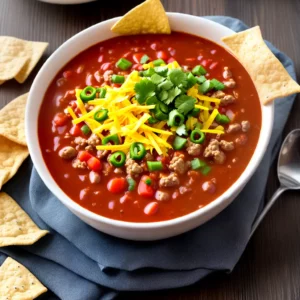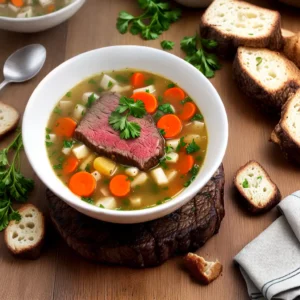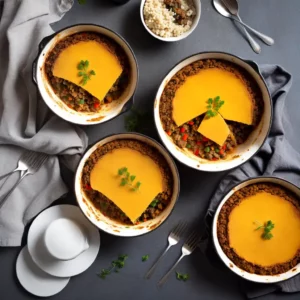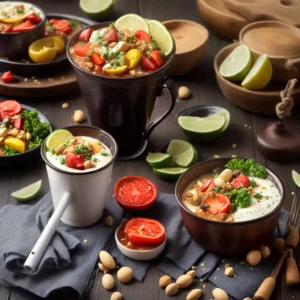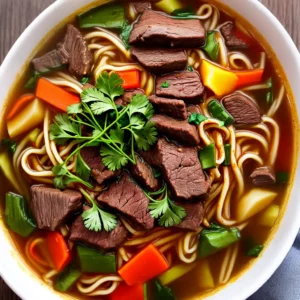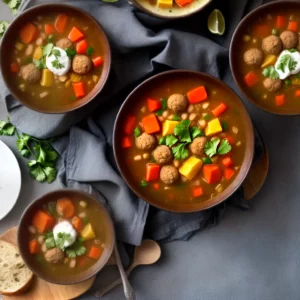As an aspiring home chef, mastering the basics of cooking is the first step towards culinary greatness. Whether you’re a complete beginner or have some experience in the kitchen, understanding the five fundamental cooking skills is essential. These skills will not only make your time in the kitchen more enjoyable but also help you create delicious meals that will impress even the toughest food critics.
In this article, I will guide you through the five basic cooking skills that every home chef should master. From knife skills to searing, making perfect scrambled eggs to roasting vegetables, and cooking the perfect steak, these techniques will elevate your culinary game to new heights.
Key Takeaways:
- Mastering the basics of cooking is essential for every home chef.
- The five basic cooking skills include knife skills, searing, making perfect scrambled eggs, roasting vegetables, and cooking the perfect steak.
- By learning and practicing these skills, you can enhance your culinary creativity and create memorable meals.
- Investing in the right tools, understanding ingredients, and continuous learning will help you become a confident home chef.
- Efficient techniques, seeking expert advice, and embracing culinary exploration are valuable aspects of your cooking journey.
Knife Skills: The Foundation of Cooking
Mastering knife skills is an essential foundation for any aspiring home chef. Properly holding and using a knife, as well as mastering basic cutting techniques, such as chopping, slicing, dicing, and more, can significantly enhance your cooking experience in the kitchen. Not only will it make your time spent preparing ingredients more efficient, but it will also elevate the overall presentation and taste of your dishes.
When it comes to knife skills, practice makes perfect. Start by ensuring you have a sharp, high-quality chef’s knife that feels comfortable in your hand. Proper grip and hand placement are crucial to maintain control and safety while cutting. Remember to position your fingers correctly, with your index finger resting on the blade for stability. This technique, known as the “claw grip,” allows for precise control over the knife and reduces the risk of accidents.
Essential Cutting Techniques
Understanding and practicing various cutting techniques can take your knife skills to the next level. Here are a few essential techniques to master:
- Chopping: Chop ingredients into rough pieces. Keep the tip of the knife on the cutting board and move the knife in a rocking motion.
- Slicing: Cut ingredients into thin, even slices. Use a smooth, steady motion with the knife moving perpendicular to the cutting board.
- Dicing: Create small, uniform cubes by first slicing the ingredient into planks, then into sticks, and finally into cubes.
- Julienne: Cut ingredients into thin matchstick-like strips. Start by creating planks and then slicing them into thin strips.
| Cutting Technique | Description |
|---|---|
| Chopping | Cut ingredients into rough pieces using a rocking motion. |
| Slicing | Cut ingredients into thin, even slices with a smooth, steady motion. |
| Dicing | Create small, uniform cubes by slicing the ingredient into planks, then sticks, and finally cubes. |
| Julienne | Cut ingredients into thin matchstick-like strips by creating planks and slicing them into thin strips. |
“Knife skills are the cornerstone of cooking. It’s not just about speed; it’s about precision and control. With proper technique, you will not only save time in the kitchen, but also ensure consistent and professional-looking results in your dishes.” – Chef David Chang
Searing: Creating Flavorful Meals
Searing is a cooking technique that involves browning the surface of meat or vegetables in a hot pan. This technique adds depth of flavor and enhances the texture of your dishes. It’s important to get your pan hot before adding the food and avoid overcrowding the pan for proper searing.
When searing meat, such as steak or chicken, heat control is crucial. Start by patting the meat dry with a paper towel to remove any excess moisture. This will help create a nice sear. Preheat your pan over medium-high heat until it’s hot, then add a small amount of oil with a high smoke point, such as vegetable or canola oil.
Place the meat in the hot pan and let it cook undisturbed for a few minutes, allowing a crust to form. Flip the meat and sear the other side. To ensure even cooking, use tongs to hold the meat upright and sear any exposed edges. Remember, searing is about creating a beautiful brown crust, not cooking the meat through.
Once the meat is seared to your liking, you can finish cooking it through in the oven or on the stovetop, depending on the thickness and desired doneness. Keep in mind that searing alone does not cook the meat completely.
When searing vegetables, such as mushrooms or zucchini, follow a similar process. Heat your pan, add a small amount of oil, and then add the vegetables. Allow them to cook undisturbed for a few minutes until they develop a golden brown color. Flip or stir the vegetables to sear the other side, and continue cooking until they are tender.
By mastering the art of searing, you can elevate the flavor profile of your meals and impress your family and friends with delicious and visually appealing dishes.
Perfecting Scrambled Eggs: A Breakfast Staple
When it comes to cooking breakfast, scrambled eggs are a classic that never goes out of style. But what’s the secret to making the perfect scrambled eggs? As a home chef, I’ve experimented with different techniques and discovered a few tips that have elevated my scrambled eggs to a whole new level.
The first key to perfect scrambled eggs is whisking them thoroughly before cooking. This helps to incorporate air and create a light and fluffy texture. I like to use a fork or a whisk and beat the eggs until they are well blended with no streaks of white or yolk remaining.
Another crucial element is cooking the eggs slowly over low heat. This allows for more control over the cooking process and prevents the eggs from becoming overcooked and rubbery. I prefer using a non-stick pan and cooking the eggs over medium-low heat, stirring continuously until they reach a creamy consistency.
To add some richness and creaminess to my scrambled eggs, I take a tip from legendary chef Gordon Ramsay and incorporate a dollop of crème fraîche or sour cream. This not only enhances the flavor but also adds a velvety texture to the eggs. Simply spoon in a small amount of crème fraîche or sour cream while whisking the eggs, and you’ll be amazed at the difference it makes.
Whether you enjoy your scrambled eggs plain or like to add in some extras like cheese, herbs, or vegetables, mastering the art of making them perfectly is a skill that every home chef should have in their culinary repertoire. So grab your whisk, turn on the stove, and get ready to whip up the most delicious scrambled eggs you’ve ever tasted!
Table: Tips for Perfect Scrambled Eggs
| Tip | Description |
|---|---|
| Whisk Thoroughly | Ensure the eggs are well blended and free of streaks before cooking. |
| Cook Over Low Heat | Slow cooking over low heat prevents the eggs from becoming overcooked and rubbery. |
| Add Creaminess | Incorporate a dollop of crème fraîche or sour cream for added richness and texture. |
| Experiment with Extras | Customize your scrambled eggs with cheese, herbs, vegetables, or other ingredients. |
Roasting Vegetables: Simple and Delicious
| Vegetable | Seasoning | Temperature (°F) | Time (minutes) |
|---|---|---|---|
| Carrots | Olive oil, thyme, garlic, salt, and pepper | 400 | 25-30 |
| Potatoes | Rosemary, garlic, salt, and pepper | 425 | 35-40 |
| Broccoli | Olive oil, lemon juice, garlic, salt, and pepper | 425 | 20-25 |
Roasting vegetables is a simple and delicious way to prepare them. It brings out the natural sweetness and enhances the flavors, resulting in tender and caramelized vegetables with a satisfying golden brown color. To achieve the perfect roasted vegetables, follow these steps:
- Preheat your oven to the recommended temperature for the specific vegetable you are roasting. Different vegetables require different temperatures to achieve optimal results.
- Cut the vegetables into uniform sizes to ensure even cooking.
- Toss the vegetables with olive oil and your choice of seasonings. Salt, pepper, and garlic are versatile options, but feel free to experiment with herbs and spices like rosemary, thyme, or paprika.
- Spread the seasoned vegetables in a single layer on a baking sheet, allowing enough space between each piece to ensure they roast evenly.
- Place the baking sheet in the preheated oven and roast the vegetables until they are tender and have developed a beautifully golden brown color.
- Remove from the oven and serve your perfectly roasted vegetables as a side dish or use them as a delicious addition to salads, pasta, or grain bowls.
“Roasting vegetables is an excellent cooking technique that brings out the best flavors and textures in a variety of vegetables. The high heat helps to caramelize the natural sugars in the vegetables, resulting in a rich and delicious taste. Plus, it’s incredibly easy and versatile – you can roast just about any vegetable you have on hand! Try experimenting with different seasonings and spices to create unique flavor profiles. Whether you’re a beginner cook or an experienced chef, roasting vegetables is a fantastic skill to have in your culinary repertoire.”
Benefits of Roasting Vegetables
In addition to their delicious taste, roasted vegetables offer several benefits:
- Increased nutrient content: Roasting vegetables helps to retain more of their natural nutrients compared to boiling or steaming, making them a healthy and nutritious choice.
- Enhanced flavor and texture: The caramelization process during roasting creates a depth of flavor and a delightful crispy texture that adds a satisfying element to your dishes.
- Time-saving and hands-off: Once the vegetables are in the oven, you can focus on other tasks or prepare the rest of your meal, making roasting a convenient cooking method.
- Versatility: Roasted vegetables can be enjoyed as a side dish, added to salads or pasta, used as a topping for pizzas, or incorporated into wraps and sandwiches, offering endless culinary possibilities.
So, the next time you want to add an extra level of deliciousness to your vegetables, give roasting a try. With a little bit of seasoning and the right oven temperature, you’ll have flavorful and tender roasted vegetables that will elevate any meal.
Cooking the Perfect Steak: A Meat Lover’s Dream
When it comes to cooking the perfect steak, there are a few key steps that will ensure a delicious and flavorful result. Start by selecting a high-quality cut of steak and properly seasoning it. Seasoning is the key to enhancing the natural flavors of the meat. Generously sprinkle salt and pepper on both sides of the steak and let it sit at room temperature for about 30 minutes to allow the seasoning to penetrate the meat.
Next, it’s time to cook the steak to your preferred level of doneness. Whether you like it rare, medium, or well-done, the cooking process remains the same. Heat a cast-iron skillet or grill over high heat until it’s smoking hot. Place the steak on the hot surface and let it cook undisturbed for a few minutes. Flip the steak and cook for a few more minutes on the other side. Use a meat thermometer to check the internal temperature of the steak to ensure it reaches your desired level of doneness.
Once the steak is cooked to perfection, remove it from the heat and let it rest for a few minutes before slicing. This allows the juices to redistribute, resulting in a tender and juicy steak. Serve the steak with your favorite side dishes and enjoy a mouthwatering meal that will satisfy any meat lover’s cravings.
Tips for Cooking the Perfect Steak:
- Choose a high-quality cut of steak
- Generously season with salt and pepper
- Let the steak sit at room temperature before cooking
- Use a hot skillet or grill to cook the steak
- Flip the steak only once to achieve a nice crust
- Use a meat thermometer to check the internal temperature
- Let the steak rest before serving
Table: Steak Cooking Levels
| Level of Doneness | Internal Temperature |
|---|---|
| Rare | 120°F – 125°F |
| Medium Rare | 130°F – 135°F |
| Medium | 140°F – 145°F |
| Medium Well | 150°F – 155°F |
| Well Done | 160°F and above |
“A perfectly cooked steak doesn’t need fancy sauces or complicated preparations. The quality of the meat, proper seasoning, and the right cooking technique are all you need to create a steak that is bursting with flavor and satisfaction.” – Chef Emily
Additional Skills Every Home Chef Should Know
Being a home chef goes beyond mastering the five basic cooking skills. To truly excel in the culinary arts, there are additional skills and knowledge that can elevate your cooking to a whole new level. Here are some essential skills that every aspiring home chef should strive to acquire:
1. Culinary Arts
To deepen your understanding of cooking, it’s important to familiarize yourself with the principles and techniques of culinary arts. This includes learning about flavor profiles, food pairings, and the science behind cooking. By studying culinary arts, you can enhance your creativity in the kitchen and develop a more nuanced palate.
2. Culinary Knowledge
Expanding your culinary knowledge involves exploring different cuisines, ingredients, and cooking methods. By broadening your culinary horizons, you’ll discover new flavors, techniques, and recipes that can inspire your cooking. This knowledge will also enable you to adapt and create your own unique dishes.
3. Quality Assurance
Ensuring quality assurance in your cooking is crucial for producing delicious and safe meals. This involves understanding food safety practices, proper storage and handling of ingredients, and implementing quality control measures. By prioritizing quality, you can create meals that are not only flavorful but also safe for consumption.
By acquiring these additional skills, you’ll have a strong foundation to experiment with flavors, create masterful dishes, and take your culinary expertise to new heights. Remember, cooking is an ongoing journey of learning and exploration, so embrace the opportunity to continuously expand your skills as a home chef.
Kitchen Essentials: Tools and Cookware
As a home chef, having the right kitchen tools and cookware is essential for creating delicious meals with ease. Here are some must-have items that every aspiring cook should have in their culinary arsenal:
Kitchen Tools:
- A chef’s knife: A versatile and sharp knife that can handle a variety of cutting tasks.
- Cutting board: Choose a durable cutting board that won’t damage your knives.
- Measuring utensils: Accurate measurements are crucial in cooking, so invest in a set of measuring cups and spoons.
- Whisk: Perfect for blending ingredients and creating smooth sauces and dressings.
- Tongs: Useful for flipping and turning food while cooking.
Cookware:
- Saucepans and pots: Essential for boiling, simmering, and making soups and stews.
- Frying pan: Ideal for searing, sautéing, and frying various ingredients.
- Baking sheet: Great for roasting vegetables, baking cookies, and more.
- Casserole dish: Perfect for baking casseroles, gratins, and other oven-baked dishes.
- Non-stick skillet: Makes cooking delicate foods like eggs and fish easier.
By having these kitchen essentials at your disposal, you’ll be equipped to tackle a wide range of recipes and cooking techniques. Remember, investing in high-quality tools and cookware will not only enhance your cooking experience but also make your time in the kitchen more efficient and enjoyable.
Table: Kitchen Essentials
| Kitchen Tools | Cookware |
|---|---|
| Chef’s knife | Saucepans and pots |
| Cutting board | Frying pan |
| Measuring utensils | Baking sheet |
| Whisk | Casserole dish |
| Tongs | Non-stick skillet |
Having a well-equipped kitchen not only makes cooking more efficient but also opens up a world of culinary possibilities. So, stock your kitchen with these essential tools and cookware, and get ready to unleash your inner chef!
Ingredients: The Building Blocks of Flavor
When it comes to cooking, understanding the role of ingredients is crucial. As a home chef, knowing how to select, prepare, and season your ingredients can elevate the flavors of your dishes and take your culinary creations to the next level.
First and foremost, it’s important to choose high-quality ingredients. Fresh produce, properly sourced meats, and flavorful herbs and spices are essential for creating delicious meals. Take the time to visit local farmers’ markets or specialty grocery stores to find the best and freshest ingredients available.
Once you have your ingredients, proper food preparation is key. This includes techniques such as washing and chopping vegetables, marinating meats, and measuring out the right amounts of spices and seasonings. By following these steps, you ensure that your ingredients are ready to be transformed into a mouthwatering masterpiece.
Lastly, seasoning is the secret ingredient that brings your dishes to life. Whether it’s a pinch of salt, a sprinkle of herbs, or a squeeze of citrus, the right balance of flavors can make all the difference. Experiment with different combinations and trust your taste buds to guide you towards the perfect seasoning.
Tips for Ingredient Selection and Preparation:
- Choose high-quality, fresh ingredients for the best flavors.
- Take the time to properly wash, chop, and marinate your ingredients.
- Measure out spices and seasonings accurately to achieve the desired taste.
Remember, ingredients are the foundation of flavor in your cooking. By selecting the best ingredients, preparing them with care, and seasoning them thoughtfully, you can create culinary creations that are both delicious and memorable.
Culinary Resources: Learning and Growing as a Home Chef
As a passionate home chef, I am constantly seeking new culinary resources to enhance my cooking skills and expand my knowledge. Learning to cook is an ongoing journey, and I rely on various sources to provide me with valuable tips, tricks, and inspiration. Here are some of my favorite culinary resources that have helped me on my cooking adventure.
Cookbooks that Inspire
One of the first places I turn to for culinary guidance is my collection of cookbooks. These treasure troves of recipes, techniques, and culinary wisdom offer a wealth of information that never fails to inspire me. From classic cookbooks by renowned chefs to specialized volumes focusing on different cuisines or cooking styles, there is a cookbook for every taste and level of expertise. I enjoy flipping through the pages, exploring new flavors, and discovering innovative cooking methods.
Online Cooking Classes
Another fantastic resource for learning and honing your cooking skills is online cooking classes. With just a few clicks, you can access a wide range of classes taught by professional chefs and culinary experts. These virtual courses provide step-by-step demonstrations, insider tips, and interactive learning experiences. Whether you want to master a specific technique, explore a particular cuisine, or simply learn new recipes, online cooking classes offer convenience and flexibility, allowing you to learn at your own pace.
“Cooking is like painting or writing a song. Just as there are only so many notes or colors, there are only so many flavors—it’s how you combine them that sets you apart.” – Wolfgang Puck
Food Blogs and Websites
The internet is a vast playground for culinary enthusiasts, and food blogs and websites are like hidden gems waiting to be discovered. From recipe repositories to food-focused blogs, there is a wealth of information available online that can help you improve your cooking skills. These platforms often feature a wide range of recipes, cooking tips, ingredient guides, and personal anecdotes from passionate home cooks and professional chefs. I love browsing through different blogs, bookmarking recipes, and getting inspired by the creativity and passion that these online communities exude.
Exploring Social Media
Social media platforms like Instagram, Pinterest, and YouTube have become hubs for foodies and home chefs alike. Following food accounts, chef profiles, and cooking channels can expose you to a diverse range of culinary content. From quick recipe videos to behind-the-scenes glimpses into professional kitchens, social media offers bite-sized bursts of inspiration, tips, and kitchen hacks. It’s a great way to stay connected with the cooking community, discover new trends, and share your own culinary creations.
Table: Culinary Resource Comparison
| Culinary Resource | Benefits |
|---|---|
| Cookbooks | – Diverse range of recipes and techniques – In-depth culinary knowledge – Beautifully presented and curated – Can be passed down as family heirlooms |
| Online Cooking Classes | – Convenient and flexible learning – Access to professional chefs and experts – Step-by-step demonstrations – Interactive learning experiences |
| Food Blogs and Websites | – Wide variety of recipes and guides – Personal anecdotes and tips from home cooks – User-friendly and accessible – Global cuisine exploration |
| Social Media | – Bite-sized culinary inspiration – Quick recipe videos – Behind-the-scenes access – Interact with cooking community |
Remember, these culinary resources are just tools to help you on your journey as a home chef. Take the time to explore and find the ones that resonate with you and your cooking style. Happy learning and happy cooking!
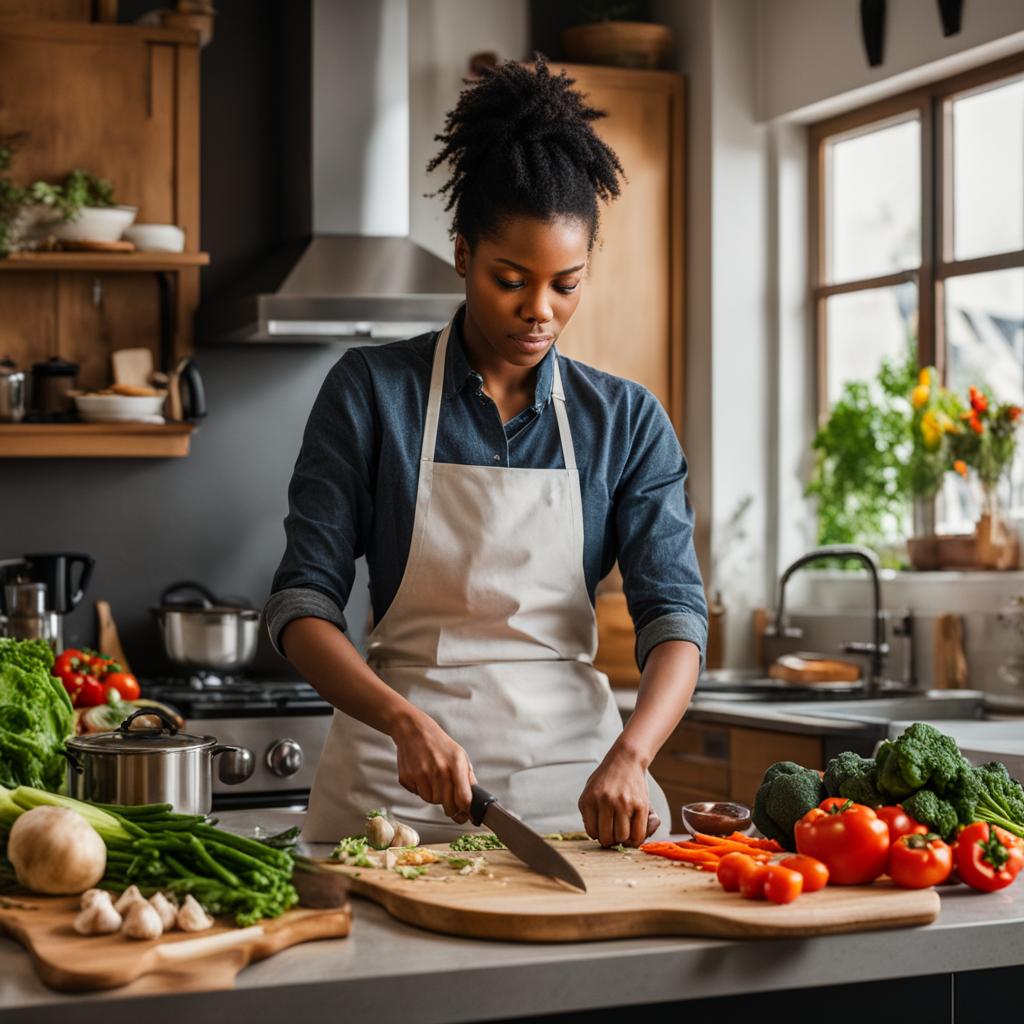
Building Kitchen Confidence: Practice Makes Perfect
As a beginner in the kitchen, building confidence can feel like a daunting task. However, with practice and a positive mindset, anyone can become a skilled home chef. Developing essential cooking skills is the key to gaining confidence in the kitchen and creating delicious meals. Here are a few essential skills that every beginner should focus on:
Knife Skills
Mastering knife skills is an essential foundation for any home chef. Learning how to hold and use a knife properly, as well as basic cutting techniques, will not only make your cooking more efficient but also elevate the presentation of your dishes. Practice your knife skills by chopping, slicing, and dicing different ingredients, and soon you’ll feel more comfortable and confident with a knife in your hand.
Mastering the Basics
Start with simple recipes that focus on the basics of cooking. By mastering techniques like sautéing, simmering, and roasting, you’ll build a strong foundation for further culinary exploration. Remember to follow recipes closely at first, but don’t be afraid to experiment and make adjustments according to your taste preferences. The more you practice, the more confident you’ll become in your ability to create delicious meals.
Embracing Failure as a Learning Opportunity
Mistakes happen in the kitchen, even to experienced chefs. Instead of getting discouraged by failure, embrace it as a learning opportunity. Every misstep is a chance to improve and grow. Remember, even the best chefs make mistakes, so don’t be too hard on yourself. Take note of what went wrong, learn from it, and keep trying. With each attempt, your confidence will grow, and you’ll become a better home chef.
| Essential Skills for Building Kitchen Confidence | Benefits |
|---|---|
| Knife skills | Efficient and precise food preparation |
| Mastering the basics | Ability to create a wide variety of dishes |
| Embracing failure | Growth and improvement as a home chef |
Building kitchen confidence takes time, patience, and practice. Don’t be afraid to step out of your comfort zone, try new recipes, and learn from your mistakes. The more you experiment and explore in the kitchen, the more confident you’ll become in your cooking abilities. So, put on your apron, sharpen your knives, and embrace the journey of becoming a skilled home chef.
The Joys of Home Cooking: Creating Memorable Meals
As a home cook, the joy of creating memorable meals is unparalleled. From the comforting aroma that fills the kitchen to the satisfaction of seeing loved ones enjoy your culinary creations, home cooking is an art that brings people together. Whether you’re following treasured family recipes or experimenting with new flavors, the act of preparing meals allows you to express your creativity and nourish both body and soul.
One of the greatest joys of home cooking is the opportunity to explore a wide variety of recipes. With countless online resources, cookbooks, and cooking shows at your fingertips, you can easily indulge your culinary curiosity and try dishes from different cuisines. From exotic spices to unique cooking techniques, each new recipe is a chance to expand your palate and discover flavors that inspire your taste buds.
Culinary creativity is at the heart of home cooking. You have the freedom to experiment, adapt, and personalize recipes to suit your own preferences and dietary needs. Whether it’s adding a pinch of your favorite herb to a traditional dish or substituting ingredients to create a healthier version, home cooking allows you to put your own unique stamp on every meal. The process of blending flavors, textures, and colors is an art form that allows you to express your individuality and create dishes that are truly one-of-a-kind.
Ultimately, the true joy of home cooking lies in the act of eating. Sitting down to a meal that you’ve prepared with love and care is a deeply satisfying experience. The flavors, the textures, and the memories associated with each dish create a sense of connection and nourishment that goes beyond sustenance. Whether it’s a cozy family dinner or a celebratory feast with friends, the act of breaking bread together creates moments of joy, laughter, and togetherness that become cherished memories for years to come.
Table: The Ingredients of a Memorable Meal
| Ingredient | Role | Key Takeaway |
|---|---|---|
| Fresh, high-quality produce | Foundation of flavor | Choose ripe, seasonal ingredients for the best results. |
| Herbs and spices | Enhancing flavors | Experiment with different combinations to create unique taste profiles. |
| Textures and contrasts | Creating interest | Incorporate a variety of textures, such as crispy, creamy, or crunchy, to add depth to your dishes. |
| Love and passion | Secret ingredient | Cook with joy and watch your meals transform into truly memorable experiences. |
So, unleash your culinary creativity, explore new recipes, and savor the joys of home cooking. Whether you’re cooking for yourself or sharing a meal with loved ones, the act of preparing and enjoying delicious homemade food is a celebration of both nourishment and connection.
Time-Saving Techniques: Maximizing Efficiency in the Kitchen
When it comes to cooking, time is often of the essence. Whether you’re a busy professional or a parent trying to balance multiple responsibilities, finding ways to save time in the kitchen can be a game-changer. By implementing a few time-saving techniques and maximizing kitchen efficiency, you can make the most of your precious minutes and enjoy the process of cooking without feeling overwhelmed.
One effective time-saving technique is meal prep. Dedicate a specific day or time each week to plan and prepare your meals in advance. Chop vegetables, cook grains, and marinate proteins ahead of time, so that when it’s time to whip up a meal, you’re already halfway there. This not only saves time but also allows for better organization and reduces food waste.
Another way to maximize efficiency in the kitchen is to streamline your cooking process. Organize your ingredients and tools before you start cooking, so you don’t waste time searching for what you need. Utilize multitasking by preparing components of your meal simultaneously. For example, while your vegetables are roasting in the oven, you can be working on the stovetop to cook your proteins or simmer a sauce. This way, you can make the most of your time and have a complete meal ready in no time.
In addition to meal prep and streamlining your cooking process, consider investing in kitchen gadgets and tools that can help speed up the cooking process. From food processors to slow cookers, these appliances can take care of time-consuming tasks, such as chopping or simmering, while you focus on other aspects of your meal. Remember, efficiency in the kitchen is not just about saving time, but also about enjoying the cooking process and creating delicious meals.
Time-Saving Tips:
- Create a weekly meal plan and grocery list to avoid last-minute decision making and trips to the store.
- Use kitchen timers or smartphone apps to track cooking times and prevent overcooking or burning.
- Prep and store ingredients in reusable containers to easily access and use them in your recipes.
- Batch cook and freeze leftovers for quick and convenient meals on busy days.
- Clean as you go to minimize post-cooking cleanup time.
By incorporating these time-saving techniques into your cooking routine, you can maximize efficiency in the kitchen and enjoy more free time for other activities. Remember, it’s not about rushing through the cooking process, but about finding ways to work smarter and make the most of your time without compromising on taste and quality.
Tips from the Experts: Learning from Culinary Professionals
When it comes to honing your culinary skills, learning from the experts can provide invaluable insights and techniques that can elevate your cooking to a whole new level. Whether you are a passionate home chef or aspiring to become a culinary professional, incorporating expert advice and chef tips into your repertoire can greatly enhance your culinary expertise and mastery in the kitchen.
One of the best ways to learn from culinary professionals is by attending cooking classes or workshops. These immersive experiences provide hands-on guidance from industry experts who can teach you the intricacies of various cooking techniques, flavor pairings, and recipe development. You’ll learn firsthand from their expertise, gaining practical knowledge and skills that you can apply to your own culinary creations.
“Cooking is an art, and like any art form, it requires continuous learning and exploration. Don’t be afraid to take risks and experiment in the kitchen. That’s where some of the most amazing dishes are born!” – Chef Emily Thompson
Books written by renowned chefs are also a treasure trove of culinary knowledge. These books often delve into the chef’s personal journey, their cooking philosophy, and share their signature recipes. By reading their insights and following their techniques, you can gain a deeper understanding of their culinary expertise and apply their wisdom to your own cooking endeavors.
Expert Tips for Home Cooks
I reached out to several culinary professionals to gather some expert tips specifically for home cooks. Here are some of their valuable insights:
- Invest in quality kitchen tools: A sharp chef’s knife, a sturdy cutting board, and reliable cooking utensils are essential for efficient and enjoyable cooking. Don’t skimp on the tools that are the foundation of your culinary adventures.
- Follow recipes as a guide, not a rule: While recipes provide a starting point, don’t be afraid to customize and experiment. Adjust seasonings, swap ingredients, and make the dish your own.
- Practice proper mise en place: Mise en place, or “everything in its place,” is a fundamental principle in professional kitchens. Prepping and organizing ingredients before you start cooking will make the process smoother and more enjoyable.
- Embrace failure as a learning opportunity: Not every culinary experiment will turn out perfectly, and that’s okay. Learn from your mistakes, adapt, and keep pushing yourself to improve.
Continuing Your Culinary Journey
Learning from culinary professionals is an ongoing process that extends beyond the kitchen. Stay updated with the latest culinary trends by following renowned chefs on social media, watching cooking shows, and exploring food blogs. Engage with the culinary community, share your creations, and learn from others’ experiences. Embracing the wisdom and expertise of culinary professionals will not only expand your culinary repertoire but also nourish your love for cooking.

Exploring the Culinary World: Embracing the Journey
Embarking on a culinary journey is an exciting endeavor that opens up a world of possibilities. Exploring different cuisines, ingredients, and cooking techniques allows you to expand your food knowledge and develop your culinary skills. It’s not just about preparing meals; it’s about immersing yourself in the art of cooking and experiencing the joy of creating and savoring delicious dishes.
As you venture into the culinary world, you’ll discover a vast array of flavors, ingredients, and cultural influences. Dive into the culinary traditions of different countries, such as the rich spices of Indian cuisine, the delicate flavors of Japanese sushi, or the comforting Italian pasta dishes. Exploring these diverse culinary experiences will not only broaden your palate but also deepen your appreciation for the world’s culinary heritage.
One of the best ways to enhance your culinary exploration is to engage with local food cultures. Visit farmers’ markets, food festivals, and specialty stores to discover unique ingredients and interact with passionate food producers. Engaging with the local culinary community can provide valuable insights, tips, and even new friendships that will enrich your culinary journey.
| Culinary Exploration Tips |
|---|
| Try new recipes from different cuisines. |
| Experiment with unfamiliar ingredients. |
| Attend cooking classes or workshops. |
| Explore food blogs and culinary websites for inspiration. |
Remember, culinary exploration is not limited to the kitchen. It involves immersing yourself in the culture, history, and stories behind the food. Discover the stories behind traditional dishes, learn about the techniques handed down through generations, and embrace the connection between food and the people who create it.
“Culinary exploration is a journey of flavors, textures, and stories. Embrace the unknown, step out of your comfort zone, and let your taste buds guide you through a world of culinary delights.” – unknown
So, embark on your culinary journey with an open mind and a curious palate. Embrace the joy of discovering new flavors, learning new techniques, and creating memorable dining experiences. Let the love for food and the desire to explore lead you on a gastronomic adventure that will continue to inspire and delight you for years to come.
| Key Takeaways |
|---|
| Culinary exploration allows you to expand your food knowledge and develop your culinary skills. |
| Engage with local food cultures to discover unique ingredients and gain valuable insights. |
| Try new recipes, experiment with unfamiliar ingredients, and attend cooking classes. |
| Embrace the culture, history, and stories behind the food you explore. |
Conclusion
In summary, mastering the five basic cooking skills discussed in this article—knife skills, searing, making scrambled eggs, roasting vegetables, and cooking steak—will provide you with a strong foundation for your culinary journey. By incorporating additional skills, such as understanding culinary arts and ensuring quality assurance, you can elevate your cooking to the next level.
Equipping yourself with the right kitchen tools and cookware is essential for a smooth cooking experience. Learning about different ingredients and how to properly season your dishes will enhance the flavors of your meals. By continuously learning and growing as a home chef and exploring culinary resources, you can stay inspired and discover new cooking techniques and recipes.
Remember, building confidence in the kitchen takes practice. Start with simple recipes, focus on mastering essential skills, and gradually challenge yourself with more complex dishes. Above all, enjoy the process of home cooking and the joy of creating memorable meals for yourself and your loved ones. Happy cooking!
FAQ
What are the 5 basic cooking skills?
The 5 basic cooking skills are knife skills, searing, making scrambled eggs, roasting vegetables, and cooking steak.
What is the importance of knife skills?
Knife skills are essential for any home chef as they make your time in the kitchen more efficient and enjoyable. They include holding and using a knife properly, as well as mastering basic cutting techniques like chopping, slicing, and dicing.
How do I properly sear meat or vegetables?
To properly sear, it’s important to brown the surface of the food in a hot pan. Make sure to get your pan hot before adding the food and avoid overcrowding the pan for proper searing.
What are Gordon Ramsay’s tips for perfect scrambled eggs?
Gordon Ramsay recommends whisking the eggs thoroughly before cooking, cooking them slowly over low heat, and adding a bit of crème fraîche or sour cream for added richness and creaminess.
How do I roast vegetables?
To roast vegetables, coat them in oil, season with salt and pepper, and roast them in a hot oven until they are golden brown and tender. This enhances the flavors and brings out the natural sweetness of the vegetables.
How do I cook the perfect steak?
To cook the perfect steak, use a hot pan or grill, season the steak with salt and pepper, and cook it to your preferred level of doneness, whether rare, medium, or well-done.
What are some additional cooking skills every home chef should know?
In addition to the basic skills, every home chef should understand culinary arts, expand their culinary knowledge, and ensure quality assurance in their cooking.
What are some essential kitchen tools and cookware for a home chef?
Essential kitchen tools include a chef’s knife, cutting board, measuring utensils, and pots and pans suitable for different cooking techniques.
How important are ingredients in cooking?
Understanding different types of ingredients, their flavors, and how to use them in recipes is fundamental in cooking. Properly seasoning dishes also enhances the flavors and makes meals more delicious.
Where can I find culinary resources and tips for home cooking?
You can explore culinary resources like cookbooks, online cooking classes, and food blogs for inspiration, new recipes, and valuable cooking tips and kitchen hacks.
How can I build confidence in the kitchen?
Start with simple recipes and gradually challenge yourself with more complex dishes. Focus on mastering the essential skills mentioned earlier and build upon them to become a confident and skilled home chef.
What are the joys of home cooking?
Home cooking allows you to unleash your culinary creativity and create memorable meals for yourself and your loved ones. You can experiment with flavors, try new recipes, and enjoy the satisfaction of preparing and enjoying a delicious homemade meal.
How can I save time in the kitchen?
Efficient cooking techniques like meal prep and organization can save you time in the kitchen. Plan your meals ahead, prep ingredients in advance, and streamline your cooking process to make the most of your time and minimize stress.
How can I learn from culinary professionals?
You can attend cooking classes, watch cooking shows, or read books by renowned chefs to get expert tips and advice that can greatly enhance your cooking skills.
How can I embrace culinary exploration?
Try new cuisines, experiment with different ingredients and techniques, and broaden your food knowledge. Embracing the journey of being a home chef will make your cooking experiences more enjoyable and fulfilling.
Source Links
- https://www.theseasonedchef.com/blog/the-five-skills-that-every-cook-needs-to-know
- https://hellskitchenrecipes.com/gordon-ramsay-5-basic-cooking-skills/
- https://www.wellandgood.com/basic-cooking-skills/
Related Recipes:
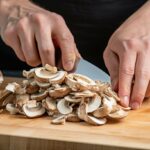 How to Cut Mushrooms? (Perfect Step-By-Step Guide)
How to Cut Mushrooms? (Perfect Step-By-Step Guide)
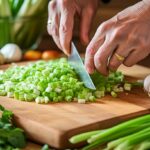 How to Cut Green Onions? (Step-By-Step Guide)
How to Cut Green Onions? (Step-By-Step Guide)
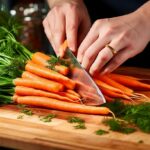 How to Cut Carrots? (Perfect Step-By-Step Guide)
How to Cut Carrots? (Perfect Step-By-Step Guide)
 How Many Cups Are in a Liter: Unlocking the Mystery
How Many Cups Are in a Liter: Unlocking the Mystery
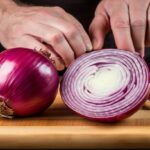 How to Chop an Onion? (Perfect Step-By-Step Guide)
How to Chop an Onion? (Perfect Step-By-Step Guide)
 Mastering How to Tell If Asparagus is Bad: Easy Guide
Mastering How to Tell If Asparagus is Bad: Easy Guide
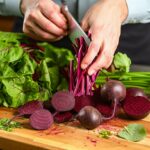 How to Cut Beets? (Perfect Step-By-Step Guide)
How to Cut Beets? (Perfect Step-By-Step Guide)
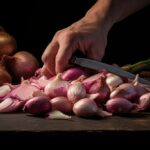 How to Cut Shallots? (Perfect Step-By-Step Guide)
How to Cut Shallots? (Perfect Step-By-Step Guide)


